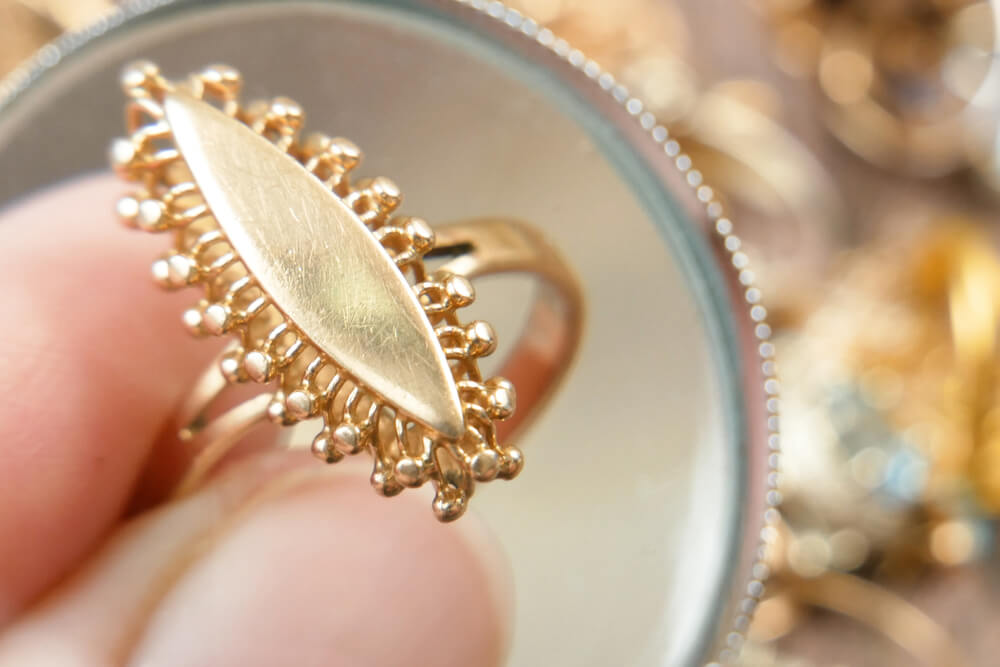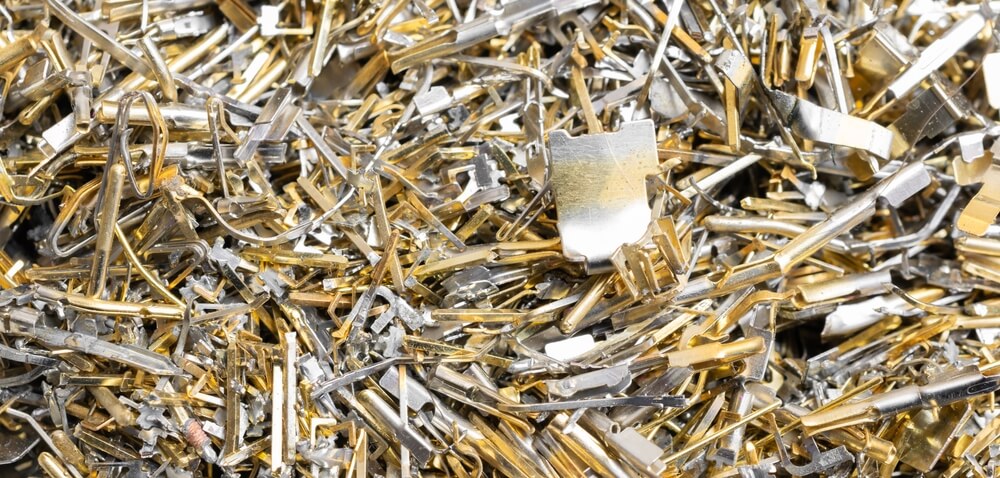
Sterling Silver vs. White Gold: What’s the Difference
When most people think of gold, visuals of shimmering yellowness slide past. Silver has a much whiter look, easily discernible from gold. But gold has skews, or it can assume different hues based on how it’s put together. In other words, it could be made to look like silver too.
Most gold items are not pure yellow gold, particularly gold jewelry. Some level of copper, nickel, or silver is added because gold is pliable. It easily disfigures. The other metals lend it rigidity.

The amount of gold and other metals in a gold alloy can vary. The lesser the amount of gold, the more likely a piece of gold jewelry will not have its characteristic pure yellow-gold hue. White gold is one of the several outcomes when gold is alloyed with other metals.
In this article, we’ll talk about white gold and sterling silver in some detail and compare the two for some perspective. The topics include:
- An introduction to sterling silver; its significance, and purpose
- What is white gold? Is it an alternative to platinum?
- Comparison between sterling silver and white gold, and more
After reading this article, we do not expect you to discern sterling silver from white gold at a mere glance. But you will undoubtedly learn much more about the two than the average Joe. Keep reading to get educated.
Table of Contents
What is Sterling Silver?
Sterling silver is silver with a twist. Silver has various applications. But it's not the most practical because it’s a naturally soft metal and reactive to oxygen in the air. Silver is mixed with other metals to make silver alloys, such as sterling silver. It’s not clear why sterling silver is called “sterling silver.” There are several theories. One of them says the word “sterling” originates from “Easterlings.”
Read more: What's the Difference Between Gold-Filled and Gold-Plated Jewelry
Sterling silver is 92.5% pure silver, and the remaining 7.5% is copper, zinc, and/or nickel. The other metal is usually copper. Nickel is not commonly used since it could present skin sensitivity concerns. Other alloy metals that may constitute the 7.5% share include platinum, zinc, silicon, germanium, and boron.
Pure silver is naturally corrosion-resistant. But sterling silver is not, thanks to copper, zinc, or nickel. However, other alloy metals used could enhance sterling silver’s capability to resist tarnish. Also, sterling silver is more rigid, which makes it easier to make jewelry out of them. Silver, however, could give in too quickly during jewelry-making or lose shape when used as daily wear.
Sterling silver pieces usually have numeric inscriptions such as “.925,” “92.5,” or “925” on them, denoting their silver content and helping with identification. Some sterling silver pieces could bear the “ss” letter markings instead.
What is White Gold?

Gold is arguably the most symbiotic when blended with other metals. Otherwise, pink, blue, green, grey, black, or white versions of it wouldn’t exist.
White gold is pure gold mixed with white metals such as nickel, palladium, manganese, or even platinum. White gold's characteristics may differ based on the other metal blended with the yellow gold in it.
For instance, white gold alloys with nickel tend to be sturdier, making the alloy ideal for rings, pins, etc. On the other hand, gold-palladium alloys are relatively soft or pliant and play well when used with precious stones or other alloy metals like platinum, silver, and copper.
Also, contrary to general perception, white gold doesn’t look completely white. White gold could be borderline pale yellow, pale rose, or tinted brown based on the mix. Most white gold pieces are made to look white with rhodium. If not for rhodium coating, the piece will have a hard time looking like platinum or sterling silver.
Gold Content
The amount of gold in white gold differs. Gold alloys usually span the 22K to 10K range. White gold is usually 18K to 14K so that the piece is gold enough and yet sturdy. A 14K white gold piece is more affordable than 18K gold and sturdier. 18-karat gold pieces strike the right balance between strength and high gold content.
Some white gold pieces could have more than 18K, up to 22K—90% gold content, with the remaining being another metal. Such pieces look a lot yellowish. They are treated with rhodium to look white (More below). Less than 14K is not common.
Rhodium Tops Things Off
Most white gold pieces are plated with rhodium, a metal from the platinum family. The white metal lends a platinum-like look to white gold, besides lending corrosion- and oxidation-resistance capabilities and adding extra luster and strength. Rhodium is skin-friendly or well-tolerated by people with sensitive skin that readily react to nickel and other metal alloys.
As alluded to above, rhodium is so vital that without it, it can be hard to achieve the pure white look white gold pieces give. But white gold wears or the rhodium cover doesn’t last forever. Based on use, it could take a few months or years for the plating to wear off. And that’s normal.
Your skin’s pH level, the toiletries it comes in contact with, environmental factors such as pollution, etc., influence the rhodium layer’s lifespan. If it’s a white gold engagement ring with plated rhodium and you never take it off, expect around six months of longevity. If the piece is not part of your everyday wear, expect more life.
When the rhodium wears off, replate your white gold jewelry with rhodium to maintain the brilliant white appearance. For some people, replating is not just about keeping the looks. If the white gold alloy has nickel and you are allergic to the metal, the worn-off rhodium could cause some significant displeasure or render the piece completely unwearable.
Luckily, rhodium plating is inexpensive (usually less than $50 for a ring), with some jewelers offering to do it for free forever or a certain number of times, provided you bought the gold there.
The rhodium plating is usually 0.75 to 1.0 microns. Less than 0.75 is too thin, and more than 1.0 microns of thickness would lead to cracks. That’s why jewelry is not made entirely from rhodium. The high costs and scarcity of the metal are other reasons.
Comparing Sterling Silver and White Gold
The following are how sterling silver and white gold are similar to each other or different:
Color and Appearance
As indicated above, the term “white gold” is a misnomer. White gold doesn’t look white in its natural state. Without the rhodium, it has more of a silvery or grayish white hue. But because “silver gold” can be confusing, the term “white gold” is adopted instead.
Although sterling silver jewelry looks very similar to traditional silver or white gold, the distinctiveness of the precious metal comes to light upon closer inspection. Sterling silver jewelry is overall brighter or shiny white. But both white gold and sterling silver suit cooler skin tones.
Durability
Gold and silver are relatively soft metals. Both white gold and sterling silver are more rigid than their base metals. White gold also doesn’t corrode, but sterling silver may form a film on top when exposed to oxygen, sulfur dioxide, and hydrogen sulfide, thanks to the other metals that are susceptible to corrosion.
Sterling silver and white gold do not need cleaning or shouldn't be cleaned. But if they look filthy, tidy them using plain water and some mild soap. Don’t use harsh chemicals or hard water as that could disintegrate the metals and make them more prone to their environment.
Cost
White gold is pricier than sterling silver. It usually even costs more than pure gold items due to its complex making process.
Mixing and coating white gold requires skill and effort. The process, as a result, is expensive—the cost is borne by the buyer. The complexity also means slower production or relatively fewer white gold pieces. That causes a demand-supply imbalance, further adding to the metal’s already high price.
Not to mention, gold mixed with platinum tends to be pricier than other gold alloys. However, when compared to platinum, white gold is more affordable and gets often touted as a cheaper alternative to the former.
Kindly note that platinum is slightly cheaper than white gold for the same weight. But because a lot more platinum is needed to make a platinum ring than an equivalent white gold ring, the former tends to be pricier.
Here’s a brief comparison between the two to give you a better idea:
Sterling silver is cheaper than white gold because it’s silver. And since sterling silver has lesser silver than pure silver, it’s cheaper than fine silver pieces. Moreover, making sterling silver by melding silver and other metals isn’t as complex a process. It’s, therefore, inexpensive on the production front too.
The total value also hinges on the specific piece and the craftsmanship involved. Silver jewelry items can cost more than gold of equivalent weight if the design or work in the latter is highly intricate. However, such silver pieces are rare.
Read more: Is Gold A Good Investment
Conclusion
White gold was introduced as a replacement for platinum. So whether you should buy white gold depends on how big a fan you are of platinum.
White gold could be a cost-efficient alternative if you fancy platinum but have always held off the purchase due to price concerns. Kindly note that white gold is not cheap per se since it contains gold and a few other popular precious metals. Moreover, making gold white is a process in itself, which also adds to the costs.
And if white gold is out of your budget, look at sterling silver.
It looks pretty similar to white gold or platinum and is cheaper too. White gold or platinum is no doubt more desirable, but there’s no denying sterling silver is an excellent start if you can’t afford the other two. Sterling silver is particularly palatable if you’re looking at costume jewelry, not fine jewelry.
For some people, it’s not just the cost element. Certain sections of the buying cohort purchase white gold even when they can afford platinum because the latter has no cultural significance. Gold is more than just precious metal. White gold strikes the right balance between looks and traditions for such individuals.
FAQs
What are the different kinds of silver alloys?
Besides sterling silver, other silver alloys include electrum, Britannia silver, shibuichi, coin silver, alpaca, European silver, and German silver. Based on the alloy type, the silver content varies. Britannia silver is 95.84% silver; shibuichi is 25% silver, and the remaining 75% is copper.
And some of them may not contain any silver, like German and nickel silver. German silver is a blend of copper, zinc, and nickel. Alpaca has just 2% silver. Irrespective of whether the alloy has silver, the other metal used is invariably copper.
Is sterling silver technically silver?
Yes, since sterling silver has 92.5% silver in it. That’s way higher than 10-karat gold pieces that qualify as “gold.” Click here to learn more about gold purity and the karat system.
Is white gold the most expensive colored gold?
A gold item’s price doesn’t increase or decrease based on its color but the amount of gold in it. To answer the question, white gold is not the most expensive of all gold alloys. But because making white gold is complex, it tends to be pricer than other forms of colored gold, with all other things equal.
Are there white gold buillion coins?
No, because there is too little gold in white gold to deem them coin-friendly or entice avid coin buyers. On the other hand, sterling silver coins are a reality because their silver content is not too far away from pure silver coins.
Is rhodium-plating white gold mandatory?
Rhodium helps white gold justify its name, but every white gold piece doesn’t have to be covered with rhodium. Many pieces shun the white metal plating and keep the original white gold look intact, appealing to people who like their white gold pieces to look less like shiny platinum or lustrous silver and more yellowish or brown. If you’re buying jewelry that’s not rhodium-plated, ensure the piece is not a nickel alloy.



